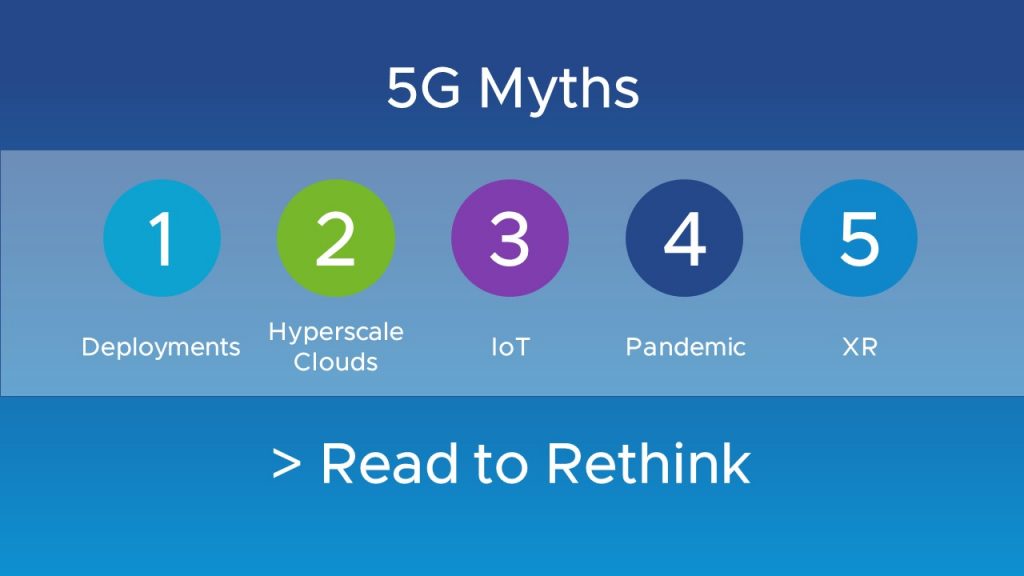
As many of you may have seen, I am about to transition from an operating role at VMware to a Special Purpose Acquisition Company focused on Telco, 5G, and Edge. As I hand over the baton to my esteemed colleague Sanjay Uppal, I am delighted to share with you some thoughts around 5G based on common assertions I’ve encountered – with the goal of helping to separate fact from fiction.
That’s what this “Think Again” column is designed to do. Periodically, our team at VMware will publish an update as an opportunity for us to add clarity on Telco and Edge topics. So, here’s the first installment for 2021!
Myth 1: Large-scale 5G deployments are another year away.
It’s true that the costs of 5G are massive; the infrastructure investment is estimated to be $80 billion by 20271. Given that expense, deployment delays would be expected IF the primary use cases were consumer oriented. But commercial use cases – like private 5G, remote work, AI applications for autonomous vehicles – are keeping global 5G deployments moving at scale and on schedule. Additionally, with the emergence of greenfield projects, like the cloud-native 5G ORAN deployment recently announced by DISH, Intel and VMware, the arrival of large-scale 5G deployments is now measured in months not years. So, yes, 5G is here folks; buckle up.
Myth 2: Hyperscale clouds can deliver the 5G Edge.
Whether it’s a hope or an assumption, there’s a notion that 5G Edge applications can be sufficiently supported by existing hyperscaler cloud infrastructure. Truth is, you can’t just graft your existing hyperscaler solution onto a new batch of distributed requirements and expect it to work. 5G Edges come with their own set of nuanced requirements around latency and scale, requiring any Edge solution to pull together communications and computing clouds in a seamless and effective way. Hyperscalers can’t dress up public clouds as low latency, distributed 5G Edges. Edge-native is the new craze … get on that train already and find the right Edge providers.
Myth 3: IoT was a passing fad.
I get it; with new technologies, there typically is an abundance of hype in the beginning with lots of ‘experts’ jumping in to show how it has promise, and a ton of startups and investment following the hope of a big return. IoT in its first phase went through this hype and subsequently cooled off. Carriers set up IoT businesses and only a few of them got returns. However, now we are entering a new and more robust, Edge-enabled phase of IoT. I am bullish about the applications in industrial automation –e.g. automation of a large-scale automotive factory shop floor — that are leveraging Edge-delivered IoT. So, no: not a passing fad.
Myth 4: The pandemic has had a slowing effect on Telco cloud and 5G deployments globally.
We’ve all seen the pervasive disruptions to life and work due to the COVID pandemic. It would be natural to expect that 5G and telco cloud deployments could be delayed — but the opposite has occurred. Driven by the shift to work-from-anywhere employment and the uptick in at-home education and entertainment, connectivity requirements have skyrocketed. That in turn, has accelerated and expanded telco cloud and 5G deployments to be faster, not slower. So NO, we aren’t seeing any slowdown in network deployments because of the pandemic.
Myth 5: 5G is what will finally drive XR into the mainstream.
Consumer applications of AR and VR have been hyped for years now – will 5G be what finally makes XR a consumer success? It’s true that XR form factors are getting better and that 5G infrastructure delivers on the low-latency, high-bandwidth requirements for rich XR experiences. But are consumers ready to embrace those still cumbersome and funky-looking goggles? Do they feel comfortable strapping around a set of gadgets 24×7? Jury’s still out on this one.
To learn more about how the VMware Telco Cloud is supporting 5G, visit https://telco.vmware.com/solutions/5g-core.html
1 Fortune Business Insights, “5G Infrastructure Market Size, Share & COVID-19 Impact Analysis,” January 2021
Discover more from VMware Telco Cloud Blog
Subscribe to get the latest posts sent to your email.








